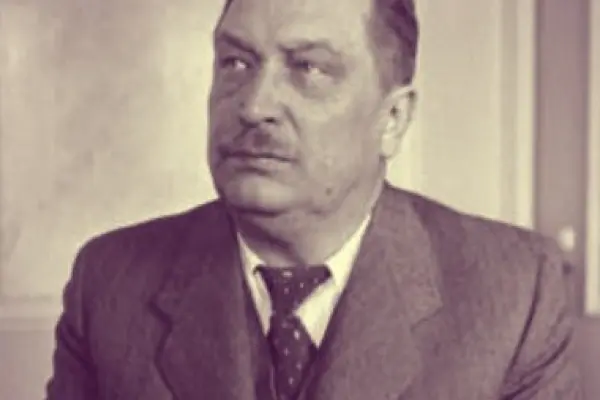Volodymyr Hnatovych Zabolotny, whose name is inscribed in the golden pages of Ukrainian architectural history, remains one of the most prominent figures in 20th-century architectural art. His life’s journey and creative legacy embody not only his personal passion and mastery but also reflect the era in which he worked. Born in the small village of Karan (now part of Pereiaslav, Kyiv Oblast), Volodymyr Zabolotny became an outstanding Ukrainian architect whose works left an indelible mark on the appearance of Ukrainian cities.
This article invites you to delve into the remarkable world of Volodymyr Hnatovych Zabolotny’s creativity, exploring his early years, the formative influences of his environment, key moments in his professional career, and his contributions to the development and transformation of Ukrainian architecture in the 20th century. We will examine his style, approach to design, and the distinctive features of his most significant projects, which continue to inspire new generations of renowned Ukrainian architects.
Early Years and Inspiration
Architect Volodymyr Zabolotny, born on August 13, 1898, in a rural setting, was surrounded by nature and folk art from childhood. Raised in the family of a master jeweler crafting church utensils, he displayed artistic talents early on. As a child, Zabolotny showed an interest in art: he designed amateur theater performances, played the violin, and engaged in sculpting and drawing, laying the foundation for his future career as an architect from Pereiaslav.
“Architecture is frozen music. Every line of a building should embody harmony, like a musical composition. In my projects, I sought to create such harmony so that people inside these buildings would feel part of something beautiful and majestic,” — Volodymyr Zabolotny told his students.
Formation of an Architect: Education and Influences
In 1921, Volodymyr Hnatovych Zabolotny enrolled in the Ukrainian Architectural Institute in Kyiv, where he received a rigorous architectural education under the guidance of notable architects of the time, including Pavlo Alyoshin. During his student years, he actively participated in architectural competitions, earning recognition for his innovative designs.
In 1928, Zabolotny successfully defended his diploma project for a 500-bed sanatorium called “Cast Away Sorrow,” designed in the spirit of Constructivism—an architectural movement that was actively developing in Soviet architecture at the time. This project showcased his ability to combine functionality with aesthetics, a hallmark of Volodymyr Zabolotny’s entire oeuvre.
Creative Path and Professional Development
After graduating, architect Zabolotny remained at the institute as a lecturer and began independent professional practice. He contributed to the development of master plans for cities such as Cherkasy, Kremenchuk, Kominternivsk, and Dniprodzerzhynsk, significantly shaping urban infrastructure. In 1934, he designed the master plan and detailed layout for the administrative center of Kryvyi Rih.
Among the realized projects of Ukrainian architect Zabolotny from this period, the Palace of Culture at the Dniprodzerzhynsk Metallurgical Plant and the Oblspozhyvspilka building in Vinnytsia stand out. These structures illustrate the evolution of his architectural style from Constructivism to the more monumental forms typical of the Stalinist era.
| Period | Main Projects | Architectural Style | Significance in Legacy |
|---|---|---|---|
| 1928-1934 | “Cast Away Sorrow” Sanatorium, planning of Cherkasy, Kremenchuk | Constructivism | Formation of an individual architectural approach |
| 1934-1939 | Palace of Culture in Dniprodzerzhynsk, Oblspozhyvspilka in Vinnytsia | Transition to monumentalism | Development of a unique stylistic synthesis |
| 1936-1939 | Building of the Verkhovna Rada of the Ukrainian SSR | Neoclassicism with Ukrainian style elements | Pinnacle of creativity, symbol of statehood |
| 1945-1956 | Scholarly works, editorial activities | Exploration of national traditions | Contribution to architectural theory and education |
The table above illustrates the evolution of Volodymyr Zabolotny’s creative path, from early experiments with Constructivism to mature works in Ukrainian Neoclassicism. Each phase of his career is marked by a search for new ways to express national identity in architecture.
The Verkhovna Rada Building: Pinnacle of Creativity
Volodymyr Hnatovych Zabolotny’s most significant work is the Verkhovna Rada of Ukraine building in Kyiv (formerly the Supreme Soviet of the Ukrainian SSR), constructed between 1936 and 1939. Located in Pechersk, near the Mariinskyi Palace, this structure became a key historical building in Kyiv and a symbol of Ukrainian statehood.
The architect designed the Verkhovna Rada building in the Neoclassical style with elements of Ukrainian architectural motifs. The three-story structure is adorned with a majestic colonnade and a large glass dome, providing natural light to the session hall. For this project, Zabolotny was awarded the Stalin Prize of the First Degree in 1940, affirming his exceptional mastery among prominent Soviet architects.
“In the Verkhovna Rada building, I sought to embody the idea of a democratic space, with light streaming through the dome from above, symbolizing openness and transparency. National motifs in the decor reflect our people’s cultural roots, while the monumental forms express the strength and stability of the state,” — Zabolotny explained the concept of his masterpiece.
Scholarly and Pedagogical Activities
In the post-war years, Volodymyr Zabolotny was actively engaged in scholarly and pedagogical work. From 1945 to 1956, he served as the first president of the Academy of Architecture of the Ukrainian SSR, playing a crucial role in studying and promoting Ukraine’s architectural heritage. Under his editorship, foundational works on the history of Ukrainian art and architecture were published.
As a professor at the Kyiv Art Institute and the Kyiv Civil Engineering Institute, Zabolotny mentored an entire generation of Kyiv architects, imparting not only technical knowledge but also his passion for national architectural traditions. His teaching methodology emphasized a deep study of historical styles combined with modern construction technologies. Zabolotny’s influence on the formation of the architectural school is comparable to that of other influential architects who shaped the development of both architecture and interior design.
A Life Episode: Saving Historical Drawings
In 1941, as World War II began and Kyiv faced occupation, Volodymyr Hnatovych Zabolotny decided to save invaluable architectural drawings and measurements of Ukraine’s historical buildings. Risking his life, he organized the evacuation of the Academy of Architecture’s archives to Ufa. For three days and nights, he personally packed the materials, meticulously labeling each folder. Thanks to his dedication, priceless documents on 17th- and 18th-century Ukrainian Baroque architecture, including measurements of St. Sophia’s Cathedral and the Kyiv Pechersk Lavra, were preserved. Upon returning to Kyiv in 1944, Zabolotny immediately initiated efforts to document and assess the damage to architectural monuments, laying the groundwork for their subsequent restoration.
Legacy and Memory
Volodymyr Hnatovych Zabolotny left behind a rich architectural legacy that forms an essential part of Ukraine’s cultural heritage. His works combine functionality and aesthetic expressiveness, reflecting a deep understanding of national architectural traditions and a commitment to innovation. The buildings he created are recognized as protected architectural monuments.
The State Scientific Architectural and Construction Library of Ukraine bears Volodymyr Zabolotny’s name, and a memorial museum in Pereiaslav houses his designs, drawings, and personal belongings. This site has become a center for studying and promoting Zabolotny’s work for new generations of architects and researchers.
“True architecture is not merely the art of constructing buildings but the art of creating spaces where people live, work, and feel connected to their nation’s history. Modern architecture must reflect the spirit of its time while preserving respect for past traditions,” — these words of Volodymyr Zabolotny became a guiding principle for many Ukrainian architects.
Volodymyr Zabolotny’s biography and analysis of his creative journey offer deeper insight into the evolution of 20th-century Ukrainian architecture, which blended elements of Modernism and Classicism. His approach to preserving national architectural traditions and using local materials anticipated modern trends in the use of biomaterials in architectural planning, where sustainability and cultural identity are key principles. Volodymyr Zabolotny is rightfully regarded as one of the pillars of 20th-century Ukrainian architecture, whose legacy continues to inspire today.

